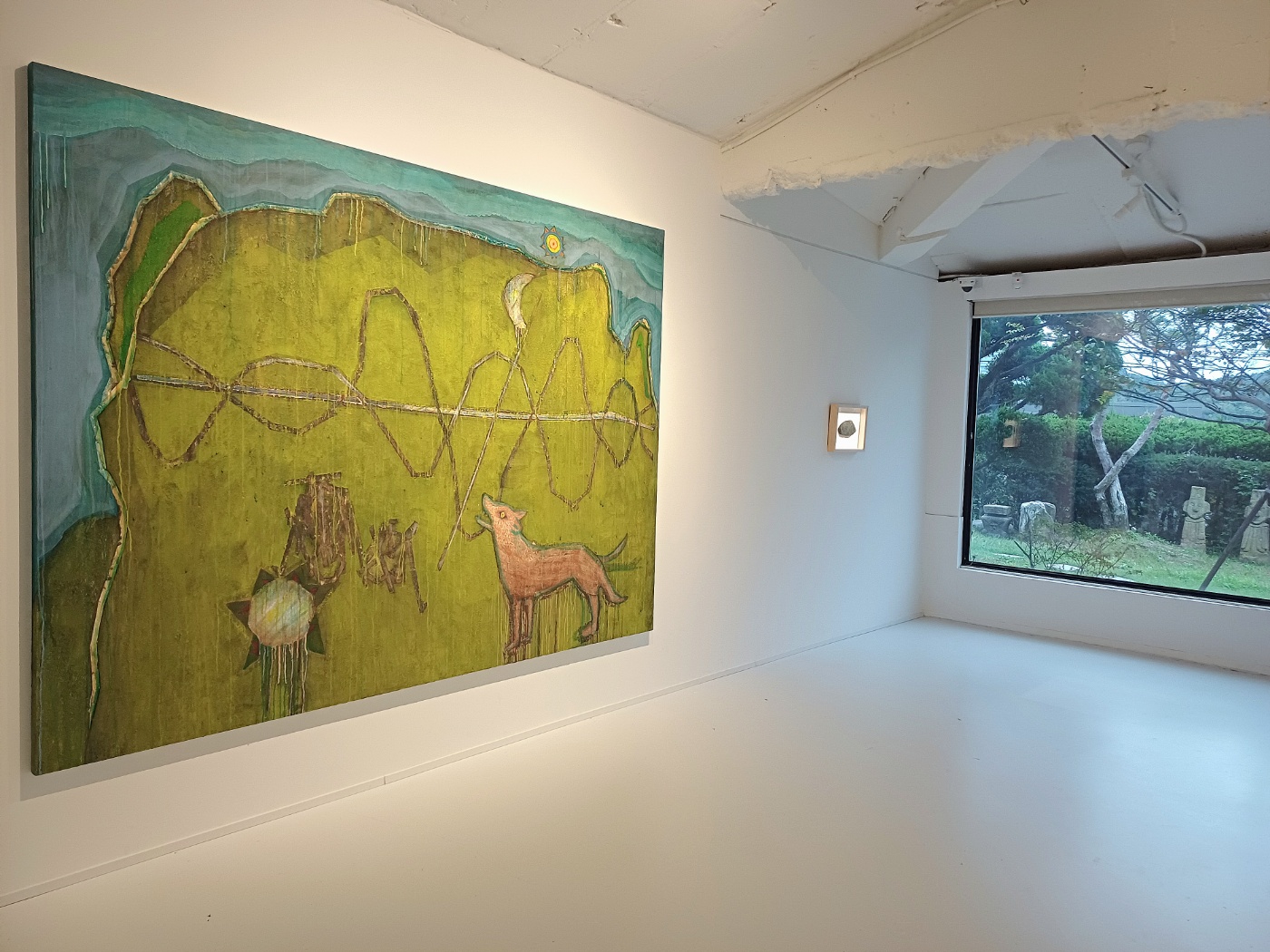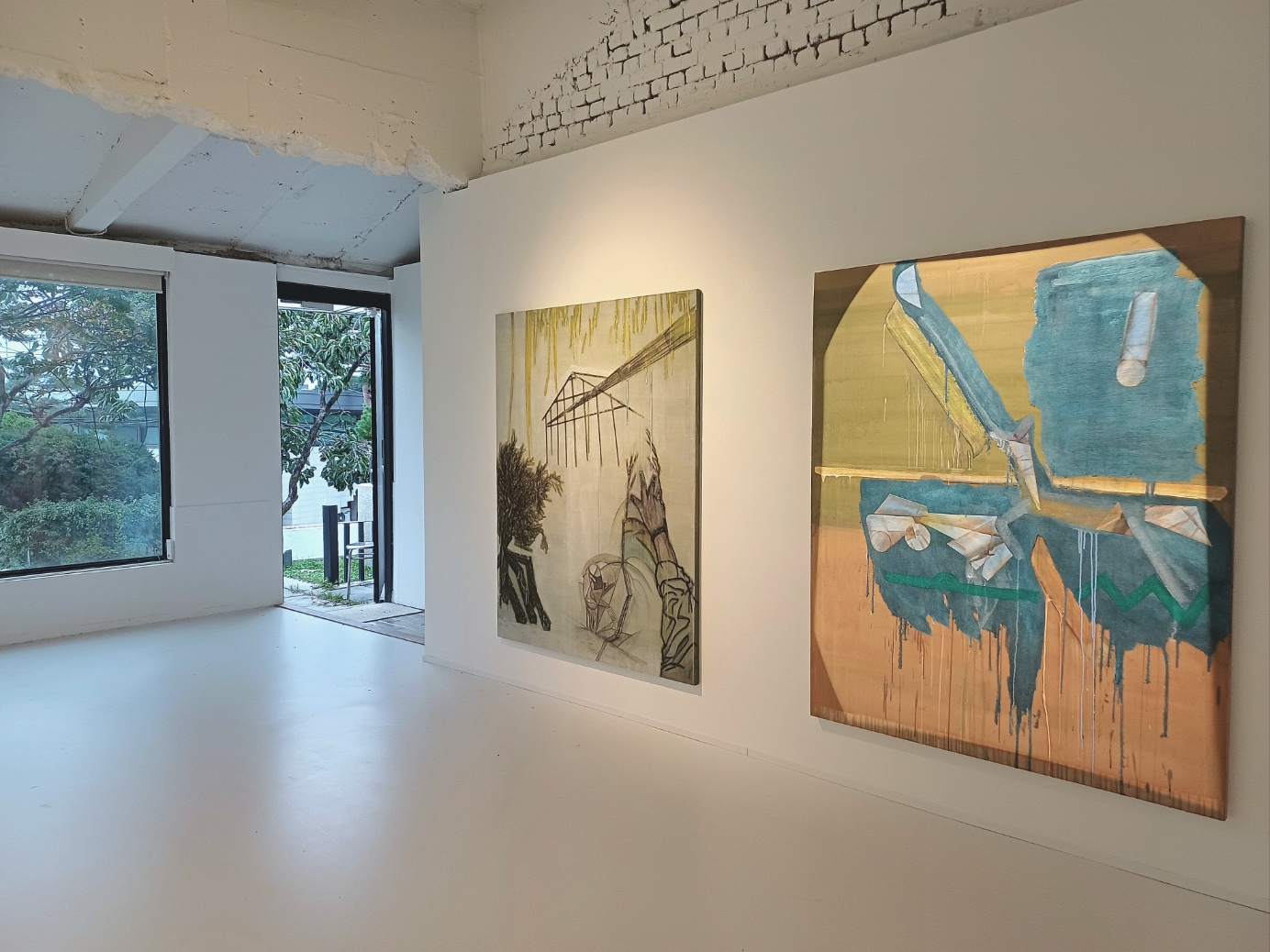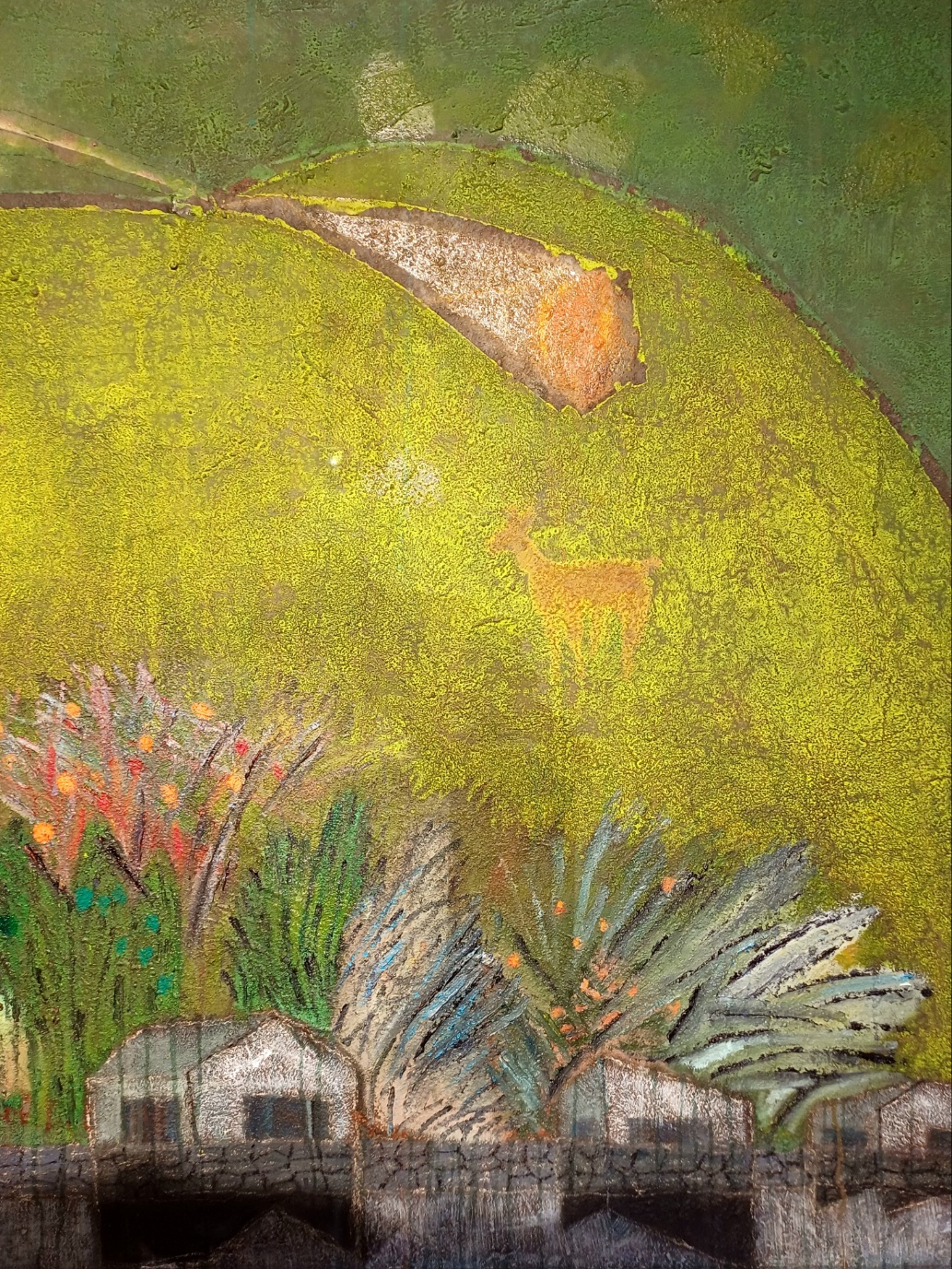Cave Cinema_Homo Pictorius
사윤택“미래로 달아나서 과거를 본다, 과거로 달아나서 미래를 보는가, 미래로 달아나는 것은 과거로 달아나는 것과 동일한 것도 아니고 미래로 달아나는 것이 과거로 달아나는 것이다. 확대하는 우주를 우려하는 자여, 과거에 살으라, 광선보다도 빠르게 미래로 달아나라.”
(시인 이상, 시 <선에 대한 각서 5> 중에서)
“회화는 현상으로부터 물질로 해석해야 될 때가 있다. 이것은 서사적 재현이 아닌 물성적 사태가 되고 싶은 작가 스스로의 태도이다.”
2023. 05.
부분적으로 나의 작업을 관통하는 태도의 기제에는 회화적 특이성에 집착하면서 회화의 상투적 관념과 형식론에 근접하고 싶지 않은 일종의 저항이 있다. 그동안 회화적 장면 탐구로 지속되는 과정은‘기억되는 순간’과‘순간의 기억’,‘현실의 순간’을 소환하는 방법론의 탐구였다. 우리는 살아가면서 시간의 흐름에 따라 기억이 망각 되고 왜곡되는 필연을 반복하게 된다. 이럴 때 기록이라는 행위와 맞물린 이미지의 투사는 과거의 기억을 재구성하는 과정에서 왜곡되고 변화되는 흐름에 의존한다. 이러한 태도의 이면에는 의식적 개입을 통해 기억을 표면화할 때 나타나는 이미지에 대한 의구심도 함께 포함되어 있다. 그렇게 의식적인 개입과 함께 또 다른 무의식이라는 감각이 엉켜들어 가면서, 시간-장면의 흐름은 얼마든지 기억이라는 사적 영역의 신화로 전이되어 가는 회화적 특이성을 드러낸다.
OKNP에서 전시되는 최근 작업은 기억의 순간, 현실로의 체험을 기록이라는 태도와 맞물려 실행하였다. 현실과 기억을 오가는 장면 체험을 고대 벽화에 등장하는 인물상의 오마주를 빌려-근원적 시간을 소환한 듯한 아우라(Aura)로–기록하는 회화적 특이성으로 전환하였다 그것은 회화로 기록되는 시간과 공간, 그 장면을 초월적 혹은 신화적 시공간으로 해석하는 대칭적 사유로의 관심에서 비롯되었다. 시간의 변화를 인식하는 현상, 마음과 물질의 관계, 현실의 체험을 제한하는 시공간의 기하학적 논리 등, 실체와 속성을 고대 벽화 양식에서 탐구해 보고자 하였다. 바로 현실에서 지각되는 시간과 공간의 윤리를 원시적 감각에서 찾아지는 초월성으로 전환하고 싶었다. 가끔 TV를 켜고 잠이 드는데, 어느 순간 잠에서 깨어 가장 먼저 접한 순간이 테니스의 운동 장면이었다. TV 속 역동적인 운동의 장면을 촬영하였다. 그리고 캡처된 장면을 미술 전공을 하지 않은 주변인에게 종이와 연필을 주며 기록을 의뢰하였다. 그렇게 표현된 형상을 다시, 암벽 분위기를 형성하기 위해 구축된 질감-요철의 평면 위에 옮겨오는 순간, 합리적인 재현의 기제는 직관(Intuition)과 원시성의 영역을 활성화한다. 그렇게 작업은 시작되었다. 나의 시공간은 현실과 동굴 속 어느 시간의 경계로 차원이동을 시작하였다.
2025. 09. 사윤택
“Fleeing into the future and seeing the past? Do you flee into the past and see the future? Running into the future is not the same as running into the past, and running into the future is running into the past. You who fear the expanding universe, live in the past, run into the future faster than a ray of light.” (A Poem by Yi Sang, ) March 2025 “There are times when painting must be interpreted as substance based on phenomenon. It is the attitude of becoming a situation rather than a narrative representation.” October 2022 A part of the mechanism of the attitude that runs through my work is a kind of resistance to adhere to the specificity of painting without getting close to the clichéd ideas and formalism of painting. And the process of exploring the pictorial scene has continuously examined the methodology to invoke ‘remembered moments,’ ‘memories of a moment,’ and ‘moments of reality.’ As life goes on, we repeat the inevitable process of our memories being forgotten and distorted. In this context, the projection of images, meshed with the act of recording, reconstructs past memories and relies on the distorted and changing flow. It perhaps implies the doubt that emerges when we transform memory into consciousness through conscious intervention. However, when our perception is based on the unconscious, we can experience the painterly specificity regarding time and memory: the public realm of ‘time’ is shifted to the myth of the private realm of ‘memory.’ Some recent works exhibited at the OKNP Gallery incorporated the experience of reality, the moment of memory, in accordance with the act of recording. I attempted to transform the act of recording into an aura that seems to recall and record the original time through the scene experience encompassing reality and memory, by borrowing the homage of the figures in the ancient murals. It aroused in me an interest in achieving a symmetrical thought that converts the aura of the scene, which is the conscious time and space recorded through the painting, into the unconscious time and space. In addition, I wanted to explore in the form of ancient murals the unconscious possibilities of time, sense, and existence, including the relationship between matter and mind, which recognizes the change of time in the geometric logic of time and space, substance and property, possibility and reality. In other words, I intended to involve the aura discovered in the primitive sense that transcends the ethics of time and space. When I accidentally woke up due to my habit of falling asleep with the TV on, the first thing I saw was a dynamic athletic scene. I filmed the athletic scene and asked the people around me, who usually live their lives without any contact with art, to draw that dynamic image. It was a kind of setting to regenerate the source of expressive behavior in ancient society before civilization, from the stance of ‘records and origins.’ The moment the requested images are drawn on the uneven surface resembling a rock wall, the memory of time activates the mechanism of irrational representation and the realm of unconscious intuition
-
사윤택
Contact


